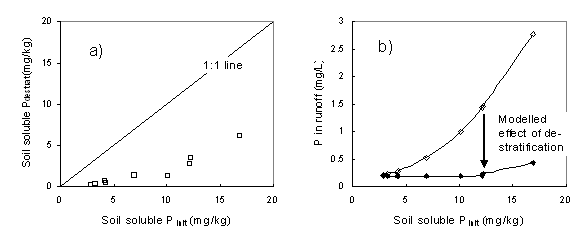
Saturday, 15 July 2006
154-54
Soil Phosphorus De-Stratification to Reduce Export of Phosphorus in Surface Runoff from a Sub-Catchment Used for Intensive Grazing.
The concentration of phosphorus (P) in runoff from dairy pastures has been shown in numerous studies in SE Australia to be undesirably high. Often systematic concentrations of P are in the range 1-5 mg/L, composed predominantly (e.g. >90%) of dissolved (i.e. <0.45 micron) forms of P. Although it is possible to reduce incidental losses of P (e.g. by not applying fertiliser immediately prior to an expected runoff event), reducing the systematic losses of P is highly desirable. The systematic concentration of P is the result of mobilisation of P primarily from the soil P pool. Because P is highly stratified in permanent pasture systems, i.e. large concentrations of P exist at the very surface (e.g. 0-1 cm), de-stratification (i.e. mixing of the topsoil by means such as cultivation) offers a method to reduce the concentration of soluble P at the soil-runoff interface. It is hypothesised that reductions in soluble P in surface soil will lead to reductions in P exported in runoff. Furthermore, because runoff containing P is typically only produced in the lower areas of the landscape, decreasing the soluble soil P pool in these areas may result in a large decrease in runoff P concentration whilst importantly minimising the impacts on pasture and farm management. A combination of laboratory studies, rainfall simulations and a catchment hydrological-P export model is being used to investigate the effect of soil de-stratification on P export in runoff from sub-catchments.
Soil samples of a wide range of fertility levels (Olsen P:23-132 mg/kg) representing the top 1 cm of soil (controls) and their corresponding (0-10 cm) increments were incubated in the laboratory at 60% field capacity (20oC) for 30 days to simulate de-stratification. Soil soluble P (10 mM CaCl2, 1:5 soil:solution, 30 mins) was then measured on the control and de-stratified soil. De-stratification reduced soluble P in the soil (P<0.001) by on average 82% (Figure 1a). This data was then used in a soil P-runoff P model derived using rainfall simulation to predict the effect of de-stratification on runoff P concentration (Figure 1b).

Figure 1. The effect of de-stratification on a) soil P and b) the modelled effect of de-stratification on runoff [P]; undisturbed soil (◊) and a de-stratified soil (♦).
The effect of de-stratification is currently being further investigated using a combination of further rainfall simulations, combined with modelling of the impact on P export at the paddock and sub-catchment scale using a hydrological model (TOPMODEL) coupled with a runoff P model.
Back to 3.3A Future Challenges in P Fertilization and the Environment - Poster
Back to WCSS
Back to The 18th World Congress of Soil Science (July 9-15, 2006)